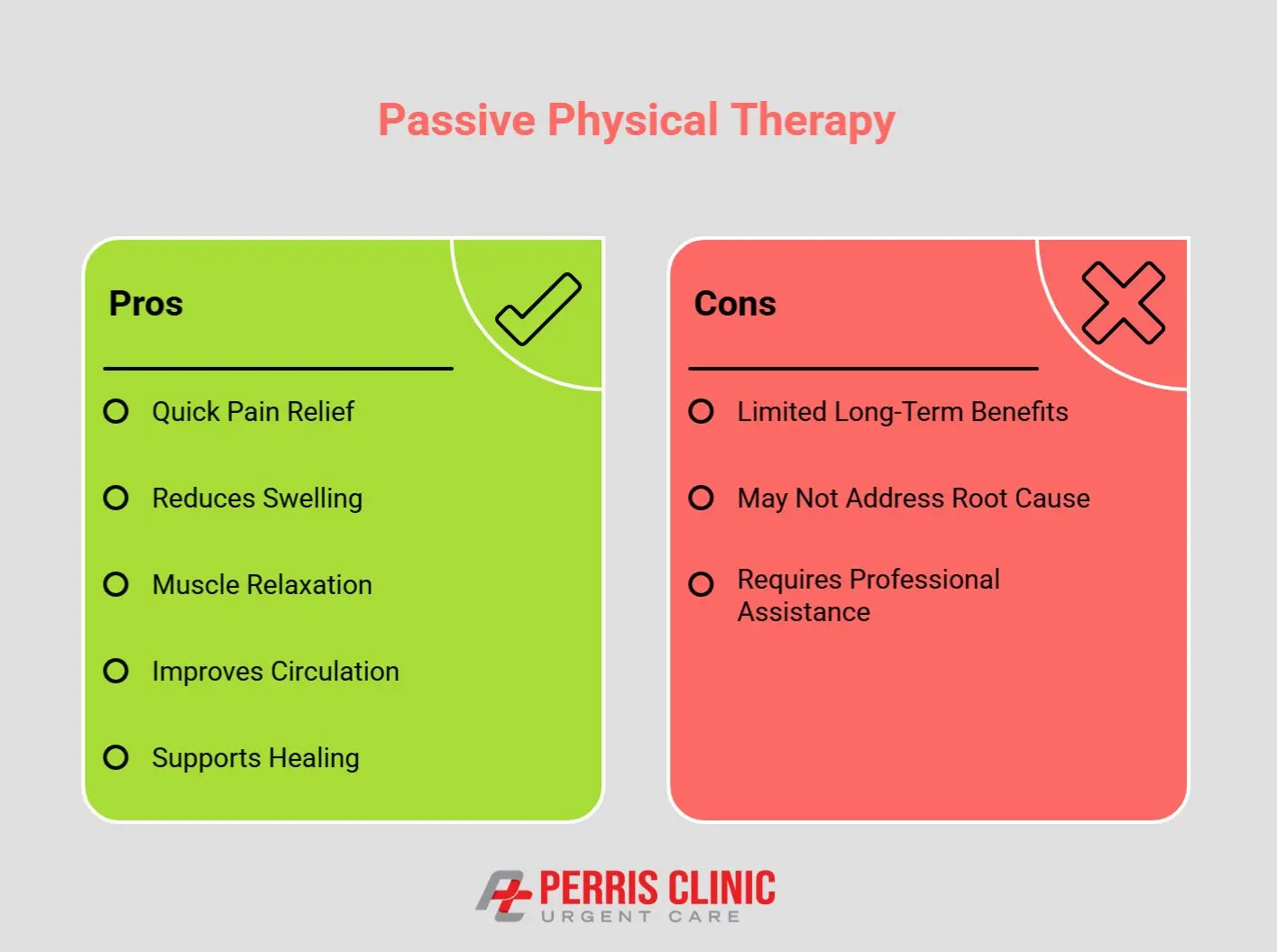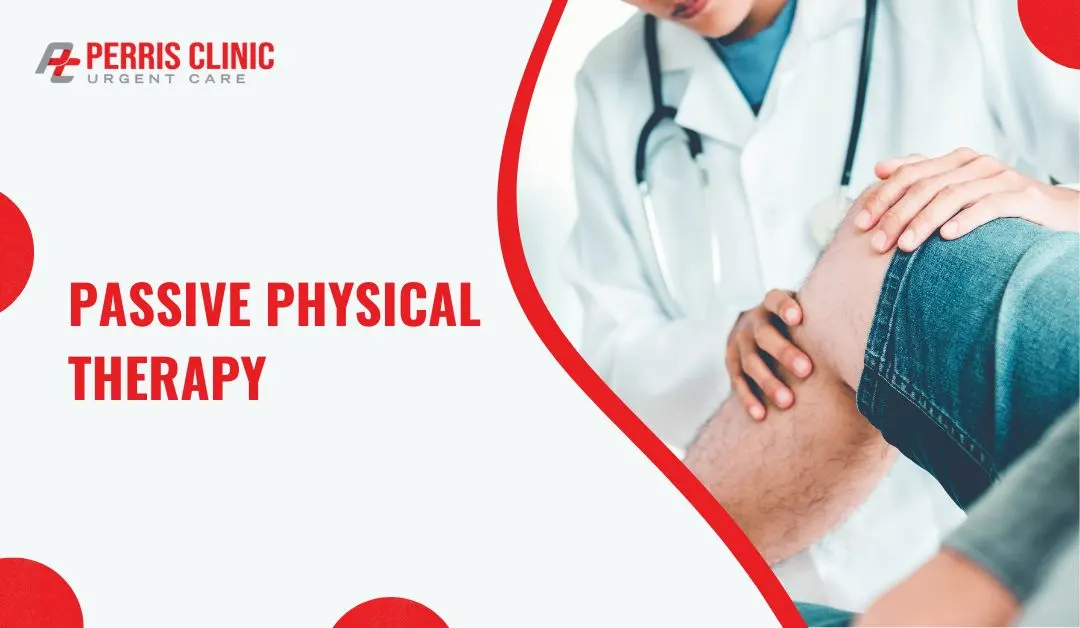Passive physical therapy helps ease pain, reduce swelling, and improve your body’s overall well-being with minimal movement. It often helps people with injuries, chronic pain, or mobility issues. Therapists use massage, heat or cold packs, and gentle electric pulses to relax your muscles and help you heal.
If you have had surgery or experience back pain or stiff joints, passive therapy can support your healing without adding extra strain. It also works well in conjunction with active rehabilitation and guidance from your primary care physician, especially early in your recovery.
Types of Passive Physical Therapy Techniques
Passive physical therapy employs various methods to support the body’s healing process and enhance overall well-being. These treatments don’t require you to move much. Therapists select the most suitable technique based on your specific pain, injury, or condition. Below are the common types of passive physical therapy you might experience.
Heat and Cold Therapy
Therapists apply heat or cold to the skin to reduce pain and swelling. Heat warms your muscles, making them relax and feel less stiff. Cold helps stop swelling after an injury. Using both can help alleviate muscle soreness and enhance blood flow. This method is simple yet highly effective for pain relief and accelerated healing.
Massage Therapy
Massage is a hands-on way to loosen tight muscles and improve circulation. A trained therapist gently presses and rubs your muscles to ease tension. Massage therapy helps your body relax and reduces pain from muscle stiffness. It also promotes healing by increasing blood flow to injured areas.
Ultrasound Therapy
Ultrasound uses sound waves to reach deep into your tissues. The waves create heat that helps reduce pain and speed healing. This gentle and non-invasive therapy is effective for conditions such as tendonitis or muscle strains. Ultrasound therapy helps your body repair itself without extra effort.
Electrical Stimulation (TENS)
TENS stands for Transcutaneous Electrical Nerve Stimulation. This method sends small electric pulses through your skin. These pulses block pain signals and relax your muscles. Electrical stimulation is often used to manage chronic pain or as a post-surgical treatment. It’s painless and can be very calming.
Joint Mobilization
Therapists gently and slowly move your joints to improve their range of motion. This technique helps with stiffness and joint pain. Joint mobilization encourages natural movement without causing strain or discomfort. It’s beneficial if you have arthritis or experience difficulty moving after an injury.
Traction
Traction gently stretches your spine or other joints, reducing pressure on nerves and discs. This can help alleviate back or neck pain and aid in recovery from spinal injuries. Traction therapy supports healing by creating space in tight areas.
These passive physical therapy techniques are most effective when a primary care provider or therapist selects the right one for your specific needs. They often combine these methods with active therapy to support your full recovery.
When Should You Use Passive Physical Therapy?
Passive physical therapy works well when your body needs help but can’t move much yet. It suits many situations where pain or injury limits your ability to be active. Let’s explore when passive therapy can make a real difference.

After Injury or Surgery
If you recently hurt yourself or had surgery, passive therapy helps reduce pain and swelling. It supports your healing when moving on your own is too painful or risky. Therapists use gentle treatments, such as massage or electrical stimulation, to aid recovery without straining the body.
Chronic Pain and Inflammation
Passive therapy offers relief for long-lasting pain, such as arthritis or fibromyalgia. Heat and cold treatments can help ease muscle stiffness and reduce inflammation. These methods enhance comfort and help you move more effectively over time.
Limited Mobility
Sometimes, injury, illness, or age can make moving problematic. Passive physical therapy can gently improve blood flow and loosen tight muscles. This helps prevent stiffness and keeps joints healthy, particularly for seniors or individuals with underlying health conditions.
Early Stage Rehabilitation
Passive therapy prepares your body for active exercises. It reduces pain and swelling, allowing you to move safely later. Primary care doctors often recommend passive therapy as the first step in a complete treatment plan.
When Movement Causes Pain
If moving causes sharp pain or worsens your condition, passive therapy is a good choice. It lets you heal without added stress. Therapists carefully select treatments that work within your body’s limitations.
Passive physical therapy often complements active treatment for optimal results. Consult with your primary care provider or therapist to determine if it aligns with your recovery needs.
Passive vs. Active Physical Therapy: What’s the Difference?
Understanding the difference between passive and active physical therapy can help you know what to expect during your treatment. Both types aim to ease pain and improve your movement, but they work in different ways.
What Is Passive Physical Therapy?
In passive physical therapy, your therapist works on your body while you stay relaxed. You don’t have to move or do exercises. Treatments such as massage, heat therapy, ultrasound, or electrical stimulation can help reduce pain and swelling. This type is helpful when you can’t move much or are just starting to heal.
What Is Active Physical Therapy?
Active physical therapy involves moving your body. You perform exercises and stretches under the guidance of your therapist. These activities help you build strength, improve balance, and regain full mobility. Active therapy is key when your body is ready to participate in recovery.
Why Use Both?
Many recovery plans include both passive and active therapy. Passive methods help ease pain and prepare your body. Then, active treatment enables you to regain strength and function. Your primary care provider or therapist will design a plan tailored to your needs and stage of recovery.
When to Choose One Over the Other?
If you have severe pain or have just had surgery, passive therapy often comes first. When your pain lessens and you feel stronger, active treatment becomes essential. Sometimes, therapists combine both approaches in the same session for more balanced care.
Knowing when to use passive or active therapy helps you recover well and safely. Always follow your healthcare provider’s advice for the best results.
Benefits of Passive Physical Therapy
Passive physical therapy offers numerous benefits, particularly when your body requires care with minimal effort. Here are the key advantages:
- Reduces Pain Quickly: Treatments such as massage and electrical stimulation help ease pain quickly.
- Lowers Swelling and Inflammation: Heat, cold therapy, and ultrasound help reduce swelling and calm inflamed areas.
- Relaxes Muscles: Massage and heat loosen tight muscles, making you feel more comfortable.
- Improves Blood Flow: Better circulation speeds up healing and delivers nutrients to injured tissues.
- Prepares Your Body for Active Therapy: Passive methods help you get ready for exercises and movements later.
- Supports Healing After Surgery or Injury: Passive therapy aids recovery when you are unable to move much.
- Safe and Gentle: This is a low-risk approach to treating pain and stiffness, particularly when movement causes discomfort.
- Helps With Chronic Conditions: People with arthritis or fibromyalgia often find relief through passive therapy.
- Can Be Combined With Other Treatments: Works well in conjunction with active therapy and medical care for optimal results.
Passive therapy not only helps reduce pain but also creates a strong base for long-term healing. It’s a wise choice when your body needs support without added stress.

How Passive Therapy Fits Into Primary Care
Primary care physicians play a crucial role in your recovery. They check your pain and movement, then suggest the best treatment. Passive physical therapy often fits into this plan to help you heal gently and effectively.
Your Doctor’s Role
Your primary care provider evaluates your condition first. They decide if passive therapy can help your pain or injury. Then, they refer you to a physical therapist or clinic for the proper treatment.
Teamwork for Better Care
At places like Perris Clinic, doctors and therapists collaborate. They share your progress and adjust treatments as needed, ensuring a smooth and complete recovery.
Part of a Full Plan
Passive therapy is one part of your care. It works best when combined with active therapy and other treatments. Your doctor guides you through each step so you heal well and safely.
Easy Access to Therapy
Primary care clinics often offer or arrange passive therapy close to home. This convenience helps you stay committed to your treatment and recover faster.
What Happens During a Passive Therapy Session
A passive therapy session is usually easy and relaxing. Therapists use different methods to help your body without asking you to move much.
Starting the Session
Your therapist will first discuss your pain or injury with you. They may check your muscles and joints to see what you need.
Types of Treatment
During the session, the therapist may:
- Apply heat or cold packs to ease pain and swelling
- Use massage to loosen tight muscles.
- Use ultrasound to help tissues heal.l
- Attach electrodes for gentle electrical stimulation (TENS)
- Gently move your joints to improve their range of motion.
- Use traction to stretch the spine if needed
How It Feels
Most people find passive therapy calming and pain-free. You might feel warmth, gentle pressure, or a mild tingling from electrical stimulation. Some soreness may occur after treatment, but it typically fades quickly.
Session Length and Frequency
Sessions typically last between 20 and 60 minutes. Your therapist will tell you how many visits you might need based on your condition.
How Can You Know If Passive Therapy Is Right for You?
Choosing the right therapy helps you heal safely and feel better. Passive physical therapy fits some needs but not all. Here are some signs it might work for you.
When to Try Passive Therapy
- You feel too much pain to move or exercise.
- You recently had surgery or an injury and need gentle care.
- You have swelling or inflammation that limits movement.
- Your doctor recommends it as part of your treatment plan.
- You have chronic pain conditions like arthritis or fibromyalgia.
When Passive Therapy Might Not Be Best
- You are now ready and able to engage in active exercises.
- Your primary goal is to build strength and enhance your fitness.
- Your therapist suggests more movement-focused rehab.
Talk to Your Doctor
Always check with your primary care provider or physical therapist. They can guide you on when passive therapy is suitable for your recovery and when to transition to active care.
FAQs About Passive Physical Therapy
How long does passive therapy take to work?
Many people feel some relief after a few sessions. Full results depend on your condition and treatment plan.
Does insurance cover passive physical therapy?
Most insurance plans cover passive therapy when a doctor or therapist recommends it. Please check with your provider to confirm.
Can I get passive therapy without a doctor’s referral?
Some clinics allow you to start therapy without a referral. It’s best to ask your clinic or insurance company about their rules.
Are there any side effects?
Passive therapy is usually safe. Although you might feel mild soreness after treatment, serious side effects are rare.
Can passive therapy help with chronic pain?
Yes, many people with arthritis, fibromyalgia, or long-term pain find relief with passive therapy.
Final Thoughts
Passive physical therapy helps you heal gently when moving is stiff or painful. It reduces pain, lowers swelling, and relaxes muscles without requiring significant effort. This type of therapy is a valuable component of many recovery plans, particularly after injury or surgery.
It works best when combined with active treatment and guidance from your primary care provider. If passive therapy could help, consider discussing it with your doctor or visiting a clinic like Perris Clinic to explore your options. Your body deserves care that fits your needs and pace.

